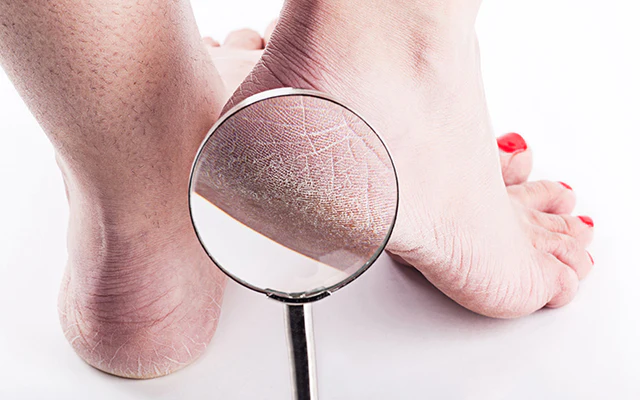Understanding and Treating Cracked Heels
Before delving into heel crack treatment, understand that cracked heels are a common foot issue that can often be managed with home remedies, such as specialized balms and exfoliation techniques.
However, if the cracking is severe or if you have an underlying condition like diabetes, it is advisable to consult a healthcare professional for more advanced treatments.
Cracked heels affect many people. A survey revealed that about 20% of adults in the United States experience cracked skin on their feet. This condition can affect both adults and children, with women being more frequently affected than men.
For most individuals, cracked heels are not a serious concern, though they can cause discomfort, particularly when walking barefoot. In severe cases, the cracks may deepen, leading to significant pain.
Below, you’ll find information on effective home remedies for treating and preventing cracked heels.
Home Treatments for Cracked Heels
- Heel Balms or Thick Moisturizers The primary treatment for cracked heels involves the use of heel balms, which are formulated with ingredients that moisturize, soften, and exfoliate dead skin. Look for balms containing:
- Urea (e.g., Flexitol Heel Balm)
- Salicylic acid (e.g., Kerasal)
- Alpha-hydroxy acids (e.g., AmLactin)
- Saccharide isomerate
These products are available over the counter at drugstores or online.
Tips for Using Heel Balm:
-
- Apply the balm in the morning to enhance skin elasticity throughout the day.
- Moisturize your heels two to three times daily.
- Wear protective footwear to guard your heels.
Note: Some heel balms may cause minor stinging or irritation. This is normal, but if irritation persists or becomes severe, consult a doctor. In severe cases, a prescription-strength balm or steroid cream may be necessary to reduce inflammation and itching.
- Soak and Exfoliate Your Feet The skin around cracked heels is usually thicker and drier than other skin, making it prone to splitting under pressure. Soaking and exfoliating your feet can help manage this condition.
Foot Soak Instructions:
-
- Soak your feet in lukewarm, soapy water for up to 20 minutes.
- Use a loofah, foot scrubber, or pumice stone to remove hard, thick skin.
- Gently pat your feet dry.
- Apply a heel balm or thick moisturizer to the affected areas.
- Lock in moisture by applying petroleum jelly over your feet, and then wear socks to prevent spreading any grease.
Important Tips:
-
- Avoid scrubbing dry feet, as this can increase the risk of skin damage.
- Consider using moisturizing heel sleeves, which function similarly to foot soaks. These sleeves are like socks infused with therapeutic oils and vitamins to treat dry skin.
By following these home remedies and tips, you can effectively manage and prevent cracked heels. However, always seek professional advice if your condition is severe or persistent, especially if you have other health concerns like diabetes.
- Liquid Bandage Applying a liquid bandage can help seal the cracks in your heels, preventing infections and further splitting. This product is typically available as a spray, allowing you to continue your daily activities without worrying about the bandage coming off. Liquid bandage is particularly useful for deep heel cracks that may bleed.
How to Use Liquid Bandage:
-
- Apply it to clean, dry skin.
- As the crack heals, the coating will be pushed to the skin’s surface.
- Liquid bandage products can be purchased over the counter at drugstores or online.
Some people have reported success using super glue to close skin cracks. A 1999 case study noted that ten individuals used two to three drops of super glue along each crack, holding the crack together for 60 seconds to seal it.
After a week, the cracks were reported to be closed and pain-free. However, commercial super glue can be toxic depending on the brand, so consult your doctor before trying this method.
- Honey Honey is a natural remedy that may help treat cracked heels. According to a 2012 review, honey has antimicrobial and antibacterial properties. Research indicates that honey can aid in healing and cleansing wounds, as well as moisturizing the skin. You can use honey as a foot scrub after a soak or apply it as a foot mask overnight.
- Coconut Oil Coconut oil is frequently recommended for dry skin conditions such as eczema and psoriasis. It helps retain moisture in the skin. Applying coconut oil after a foot soak can be beneficial, as its anti-inflammatory and antimicrobial properties can help prevent bleeding and infections in cracked heels.
- Other Natural Remedies Several other home remedies can be used to treat cracked heels, focusing primarily on moisturizing and softening the skin. While none of these remedies are specifically proven to treat cracked heels, they can be beneficial for overall foot care.
These remedies include:
-
- Vinegar, for a foot soak
- Olive or vegetable oil, for moisturizing
- Shea butter, for moisturizing
- Mashed bananas, for moisturizing
- Paraffin wax, to seal in moisture
- Oatmeal mixed with oil, for exfoliation
By following these home remedies and tips, you can effectively manage and prevent cracked heels. However, always seek professional advice if your condition is severe or persistent, especially if you have other health concerns like diabetes.
Causes and Symptoms of Cracked Heels
What Causes Cracked Heels?
The initial sign of cracked heels is the development of dry, thickened skin, known as calluses, around the rim of the heel. As you walk, the fat pad under the heel expands, causing the calluses to crack.
Other contributing factors include:
- Prolonged standing
- Walking barefoot or wearing open-back sandals
- Taking long, hot showers
- Using harsh soaps that strip the skin of natural oils
- Wearing shoes that do not fit properly or lack heel support
- Exposure to dry climates, such as cold temperatures or low humidity
Failing to moisturize your feet regularly can exacerbate dryness, leading to cracked heels.
Medical Causes
Several medical conditions can contribute to dry skin and cracked heels, including:
- High blood sugar and poor circulation due to diabetes, which can also cause nerve damage that reduces awareness of dry, cracked, and painful feet.
- Vitamin deficiency
- Fungal infections
- Hypothyroidism
- Atopic dermatitis
- Juvenile plantar dermatosis
- Psoriasis
- Palmoplantar keratoderma, which causes abnormal skin thickening on the soles and palms
- Obesity
- Pregnancy
- Aging
Associated Symptoms
In addition to cracked heels, you might experience:
- Flaky skin
- Itching
- Pain, potentially severe
- Bleeding
- Red, inflamed skin
- Ulceration
Severe cases of cracked heels, especially those related to medical conditions, can lead to complications such as:
- Loss of feeling in the heel
- Cellulitis (an infection)
- Diabetic foot ulcers
Symptoms of infection include pain, warmth, redness, and swelling. If you suspect an infection, contact your doctor immediately.
How to Prevent Cracked Heels
Footwear Choices
Your choice of footwear is crucial in preventing cracked heels. Consider the following tips:
- Opt for Properly Fitting Shoes: Choose shoes that provide adequate support and cushioning for your heels.
- Preferred Shoe Types: Wear shoes with a sturdy, wide heel that supports and cushions your heels.
- Avoid These Shoes:
- Flip-flops and sandals, which can dry out your feet.
- Open-back shoes that don’t provide enough heel support.
- High heels with tall, skinny heels that cause your heel to expand sideways.
- Tight shoes that constrict your feet.
Additional Prevention Tips
- Avoid Prolonged Standing or Sitting: Refrain from standing in one position or sitting with your legs crossed for extended periods.
- Moisturize Regularly: Apply a thick foot cream at night and cover your feet with socks to lock in moisture.
- Daily Foot Inspections: Check your feet daily, especially if you have diabetes or another condition that causes dry skin.
- Use Orthotics: Wear custom shoe inserts to cushion your heel and distribute weight evenly.
- Padded Socks: Invest in good quality or clinically-tested padded socks.
- Silicone Heel Cups: Use silicone heel cups to keep the heel moisturized and prevent the heel pad from expanding.
- Stay Hydrated: Drink plenty of fluids to maintain hydration.
- Exfoliate Gently: Use a pumice stone after showering a few times a week to prevent skin thickening. Avoid removing calluses if you have diabetes or neuropathy, as you may inadvertently create a wound and increase the risk of infection.
Takeaway
In most cases, cracked heels are not a cause for serious concern and can be treated with over-the-counter or home remedies. However, if you have a severe case of cracked heels or an underlying medical condition such as diabetes, it is essential to consult a doctor to prevent potential complications.
Although you may see initial improvement after treatment, it may take several days or weeks for the cracks to heal completely.
During and after this time, continue wearing properly fitting shoes and practice good foot care to prevent new heel cracks from forming.
Benefits of Eating Pomegranate
Foods to help with Constipation

A graduate of Computer Science and Information Management Technology. Diploma – Caregiving, Certificates – Dementia and Diabetes Awareness and Management. A researcher, blogger, songwriter, singer and acoustic guitarist. Born in an environment where natural talents such as healing are imparted at our natural birth. This natural talents of healing is the result of our genetic inheritance and the training from family environment.













